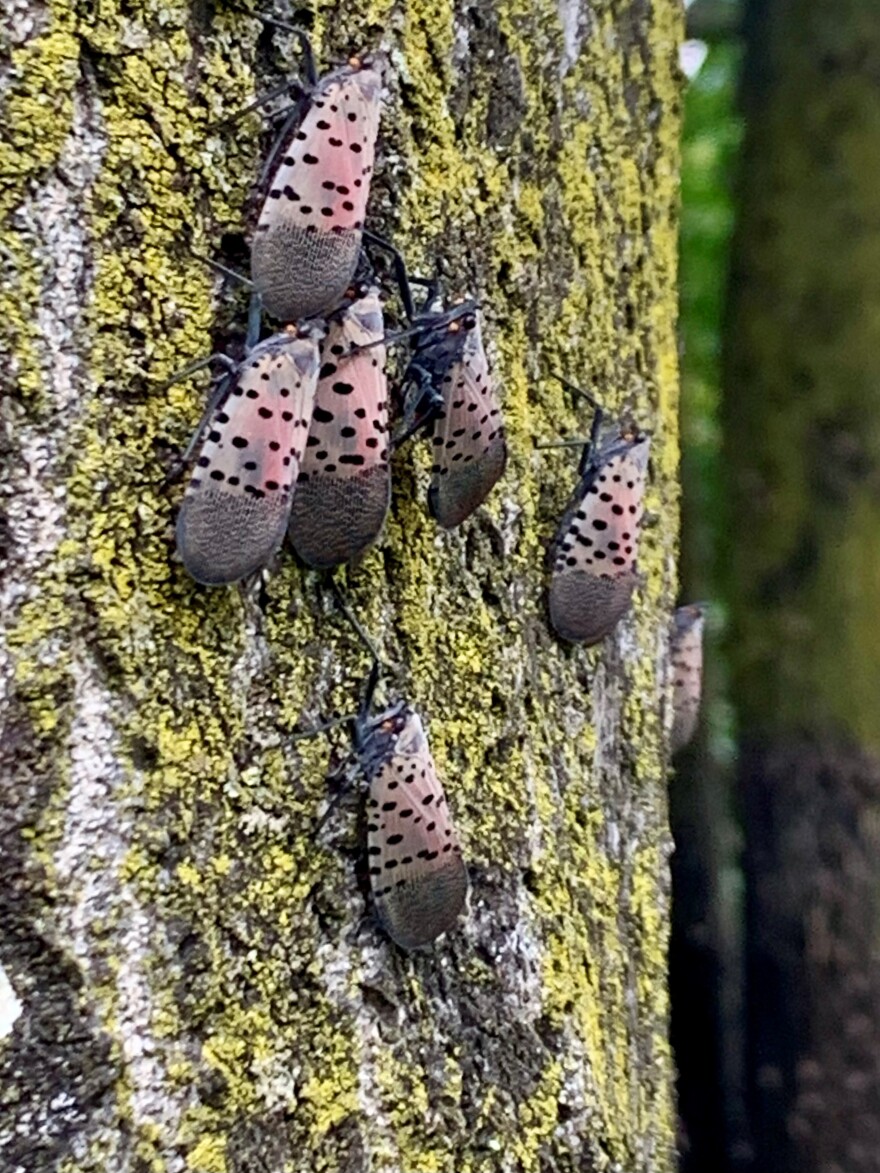In a bright yellow shirt and grey ballcap, Adam Fariss stands amidst the grape vines he planted with his father 12 years ago. His vineyard grows seven different varieties of grapes, but he knows this could all be wiped away, if the spotted lanternfly makes it to his farm in rural Pulaski County.
“Every year you encounter something new, so right as soon as you think you’ve got it figured out, everything changes,” Fariss said.
170 miles to the northeast, in Albamarle County, head winemaker at Loving Cup Vineyard, Karl Hambsch, is also anxiously watching for spotted lanternflies.
“This is a vineyard killer. At least it has been in Pennsylvania,” Hambsch said.
Scientists believe the insects first traveled to Pennsylvania from China in 2014. Spotted lanternflies traveled to Virginia four years later. Now, they’re spreading across the commonwealth and in more than a dozen states.
The wine industry in Virginia is growing— it grew nearly 30 percent from 2015-2019, according to a report by Economic Forensics and Analytics. The Virginia wine industry is worth at least 1.7 billion dollars, as of 2019. But spotted lanternfly puts all that at risk. In addition to grapevines, the bugs also damage maple trees, so syrup production could also take a hit.

During the next few months, the insects are in their adult stage and will be the easiest to spot. “The adults are about an inch long from the head to the tip of the wings,” said Teresa Dellinger, who works at the insect identification lab at Virginia Tech.
She points to a bright red wing on one specimen. “So when they’re flying though, they’ll flash those wings out, and they’re actually a pretty attractive insect.”
Spotted lanternflies burrow into grapevines, eating their sap and stressing the plants. “My understanding is that in Pennsylvania, entire blocks of grapes were lost due to spotted lanternfly,” Dellinger said.
Dellinger said so far, she’s not aware that any grapevines or crops in Virginia have been killed due to spotted lanternflies. To stop the spread, in July, the Virginia Department of Agriculture and Consumer Services issued a quarantine for 12 counties and 10 cities, which restricts farmers who transport crops out of the quarantine zone. There had already been a quarantine for the city of Winchester and Frederick County, but the agency said the bugs have now been identified in the central and Western part of the state.

Spotted lanternflies are proliferating along most of the major interstates and highways along central and Western Virginia, along I-81, I-64, and highway 29, which puts Hambsch’s farm right in the crosshairs of several outbreaks.
“Yeah we’re possibly the most vulnerable vineyard in the state when it comes to this pest,” Hambsch said.
That’s because Loving Cup is Virginia’s only certified organic vineyard. There are sprays that kill the insects, but organic insecticides haven’t been very effective. Hambsch is working with extension agents to come up with a game plan for what to do if the insects make it to his farm.
“I know we don’t have to figure it out today. We may not even need to next year. But eventually we’ll need a solution.”
He’s hoping that the USDA will give the all clear to release a wasp, also from China, which is the spotted lanternfly’s main predator there. But scientists would have to first assess what other damage the wasps could do, and what other insects they may eat.
In the meantime, Hambsch urges anyone visiting a winery to make sure they don’t accidentally transport the insect. Look for them in cars, backpacks and on your clothes.
“And when you see it, smoosh it, which is pretty upsetting for most people, including me. But that may be all the community can do right now, just to slow its spread into the area,” Hambsch said.
And if you move any object that’s been outside or get a delivery, make sure it doesn’t have any egg nests, which look like fist-sized mounds of dirt.
“The egg stage is very cryptic,” Dellinger said. “It looks like a splash of mud. It could be easily overlooked.”

There’s a third thing people can do, said Dellinger: Kill tree of heaven.
“Spotted lanternflies love tree of heaven. They evolved together over in China. So it’s a good chance that if spotted lanternfly gets moved, there’s probably gonna be a population of tree of heaven nearby that it can find and use it as a food host.”
Hambsch said he’s killed any tree of heaven on his property, and is hoping his neighbors do the same. And if things get really bad, he said he may even consider closing his winery to the public.
“Yeah I’ve thought about it. You could really make a case for shutting the winery down for a couple of years.”

Back at Iron Heart winery, Farris is researching which insecticides are most effective at killing spotted lanternfly. He hopes he won’t have to spray. “And especially at a delicate time of the year when you’re getting prepared to harvest your fruit for human consumption,” Farris said. “So we’re cautiously waiting to see if we encounter them, and what to do about them when we do.”
During the next few months, the insects will be the easiest to spot. Next spring, when spotted lanternfly eggs hatch— that’s when the real test to Virginia’s vineyards will begin.
This report, provided by Virginia Public Radio, was made possible with support from the Virginia Education Association.


